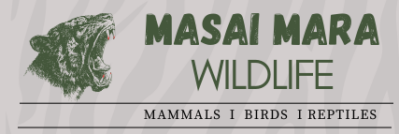- Common Names: Bushbuck
- Swahili Name: Mbawala or Pongo
- Maasai Name: Olpua
- Scientific Name: Tragelaphus scriptus
- Size:
- Head-Body Length: 175 cm (69 inches)
- Shoulder Height: 80 cm (31 inches)
- Gestation: 26–30 weeks
- IUCN Status: Least Concern. Despite local threats like habitat loss, the species remains widespread across its range, including in protected areas like Masai Mara.
Recognition and Appearance
The Bushbuck is an elegant antelope with a slim, reddish-brown coat that may appear darker in older males. Both males and females exhibit vertical white stripes down the flanks, alongside numerous white facial markings. Males stand out with their straight, spiraled horns, which can grow up to 50 cm (20 inches) long. A distinguishing feature is the crest of hair that runs along the arched back, giving the animal an even more graceful appearance.
Habits and Behavior
Bushbucks are generally shy and elusive, preferring to keep a low profile in thick vegetation. They are solitary and non-territorial, though they often establish home ranges that overlap with others. Their shy nature makes them tricky to spot, but around camps and lodges in the Masai Mara, they can become surprisingly tame, wandering through at various times of the day or night.
Their most noticeable sign of presence is their gruff bark, which they use to alert other Bushbucks to a nearby threat, often followed by a swift retreat into thick cover. While typically solitary, they may gather in small numbers where resources like fallen fruits and water are abundant.
Diet and Feeding Habits
Bushbucks are browsers, feeding on a diet consisting of leaves, herbs, seeds, and fruits. They have a preference for nutritious foliage, and their ability to feed in more forested and riverine areas helps them thrive in a variety of habitats.
Where to Find in Masai Mara
In the Masai Mara, Bushbucks are most commonly found at the edges of forests or in riverine woodland. They also inhabit well-wooded savanna areas, often near water sources where their preferred vegetation is most abundant. Although they are challenging to spot due to their reclusive habits, early morning or late afternoon sightings near rivers and waterholes are more common.
Conservation Status
Bushbucks are listed as Least Concern by the IUCN due to their wide distribution and adaptability to various habitats, including protected regions like the Masai Mara. However, habitat loss and hunting in certain regions pose localized threats. Conservation efforts within parks and reserves are essential to maintaining stable populations.
Interesting Facts
- Bushbucks display unique black and white markings on their face, ears, legs, and tail, which are thought to play a role in intraspecies signaling.
- Unlike many other antelope species, Bushbucks are known for their non-territorial nature, which allows for more fluid interactions within shared ranges.
- Despite their shy nature, Bushbucks have been observed to tolerate human presence in more protected and habituated environments like camps, providing visitors with rare and close-up views.
Their combination of beauty, elegance, and elusiveness makes the Bushbuck a fascinating species for keen-eyed safari-goers in the Masai Mara.
